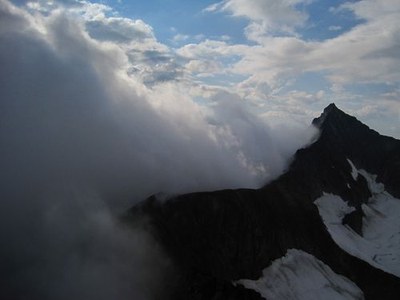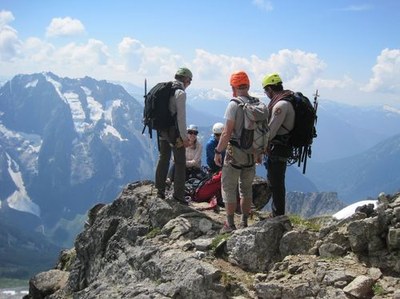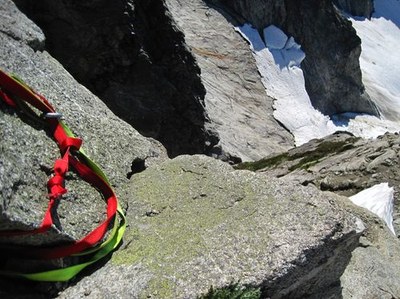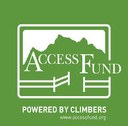
Written by Joe Sambataro, Northwest Regional Director for The Access Fund
Forbidden Peak attracts thousands of climbers from all parts of the world. Its knife blade ridges tower over glaciers below and provide breathtaking views of the Stephen Mather Wilderness of North Cascades National Park (NOCA). The West Ridge, cited as one of America’s Fifty Classic Climbs, sees a significant amount of traffic from aspiring mountaineers and experienced alpinists alike, and has been the center of attention due to controversy over fixed anchors.
 In March, the Access Fund published a blog post, North Cascades National Park Skirts DO#41 Guidelines, questioning the circumstances under which the park removed bolts from the descent of the popular Forbidden Peak. The removal of these bolts initiated a collaborative response by Access Fund and its partners to urge NOCA to establish protocol for fixed anchors that aligns with generally accepted practices and the National Park Service’s recent Director’s Order #41. (For an overview of what DO #41 means for climbing and bolts, see this blog post.) Access Fund and twelve climbing, environmental, and wilderness organizations agreed that an important step for considering a protocol was to complete an objective assessment of Forbidden Peak’s fixed anchors by a team of climbing and wilderness experts.
In March, the Access Fund published a blog post, North Cascades National Park Skirts DO#41 Guidelines, questioning the circumstances under which the park removed bolts from the descent of the popular Forbidden Peak. The removal of these bolts initiated a collaborative response by Access Fund and its partners to urge NOCA to establish protocol for fixed anchors that aligns with generally accepted practices and the National Park Service’s recent Director’s Order #41. (For an overview of what DO #41 means for climbing and bolts, see this blog post.) Access Fund and twelve climbing, environmental, and wilderness organizations agreed that an important step for considering a protocol was to complete an objective assessment of Forbidden Peak’s fixed anchors by a team of climbing and wilderness experts.
I joined this team of experts on August 18th and climbed the late-season approach to the West Ridge, helping the team document, analyze, and photograph the various fixed anchors used to rappel the route. The park sent two climbing rangers to accompany our assessment team.

Assessment Team
Doug Walker, American Alpine Club and the Wilderness Society
Jeff Ward, American Mountain Guides Association and North Cascades Mountain Guides
Joe Sambataro, Access Fund Northwest Regional Director
Jonah Harrison, Washington Climbers Coalition
Katherine Hollis, The Mountaineers
Mark Butler, Independent Consultant and Former NPS Superintendent
With high rock fall hazard in the area, we carefully coordinated teams of two to ascend and descend. While the preferred method of reaching the West Ridge is a prominent snow gully, it melts out as early as July, forcing climbers to ascend and descend rock to the left of the main gully. This section of the mountain is notorious for loose rock, demanding we exercise extra caution.
During the climb, we assessed the climbing conditions, the need for fixed anchors (bolts specifically), and various options for climbing management at NOCA. Following our assessment, we replaced worn slings with new cord along the preferred line of alternate descent when the snow gully is melted out. We also removed poorly placed rappel stations in an effort to steer climbers in the best direction, improve the visitor experience, and mitigate the impact of extraneous rappel stations.

The two park climbing rangers, Interim Wilderness District Ranger Kevork Arackellian and Wilderness Ranger Erin McKay, climbed the East Ridge and joined our team for the descent, but did not formally participate in the evaluation. The assessment team shared positive dialogue with the rangers, who dedicate their time to stewarding these remote alpine areas, coordinating rescues, and managing wilderness recreation.
Now back on solid ground, we are working to compile our observations and share insights on NOCA fixed anchor management and how the fixed anchors on Forbidden Peak might impact Wilderness character, as listed in the Wilderness Act’s section 2(c): natural, untrammeled, solitude or a primitive and unconfined type of recreation, undeveloped, and other features of value. While Forbidden Peak’s West Ridge is the focus of the assessment, we will also evaluate fixed anchors in the broader context of the Stephen Mather Wilderness Area. Access Fund Policy Director Erik Murdock will work to publish the assessment team’s findings into a final report.
Thanks to all the team members, the assessment climb was a success. This day in the field created a positive framework for working more collaboratively with NOCA as they develop their Wilderness Stewardship Plan. We thank both rangers who accompanied the assessment team, as well as Park Superintendent Karen Taylor-Goodrich for their time and efforts.
It is the sincere hope of Access Fund and our partners that this report will help inform North Cascades National Park in their effort to find a balanced approach to fixed anchors. As the first formal field assessment of fixed anchors since the issuance of NPS Director’s Order #41, this report will also serve as an example for other wilderness climbing areas around the country.
- Joe Sambataro, Access Fund Northwest Regional Director

Add a comment
Log in to add comments.An update from the Access Fund on bolts in designated Wilderness areas across the country, including North Cascades National Park:
http://www.opengate.org/access-fund-blog/2015/07/nps-wilderness-climbing-management-the-good-the-bad-and-the-ugly.html
 Joe Sambataro
Joe Sambataro